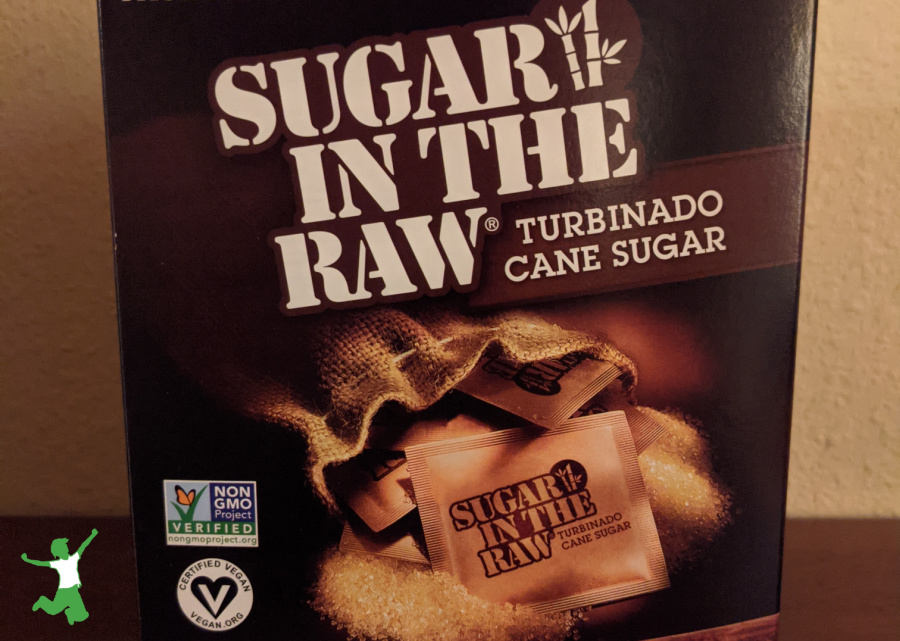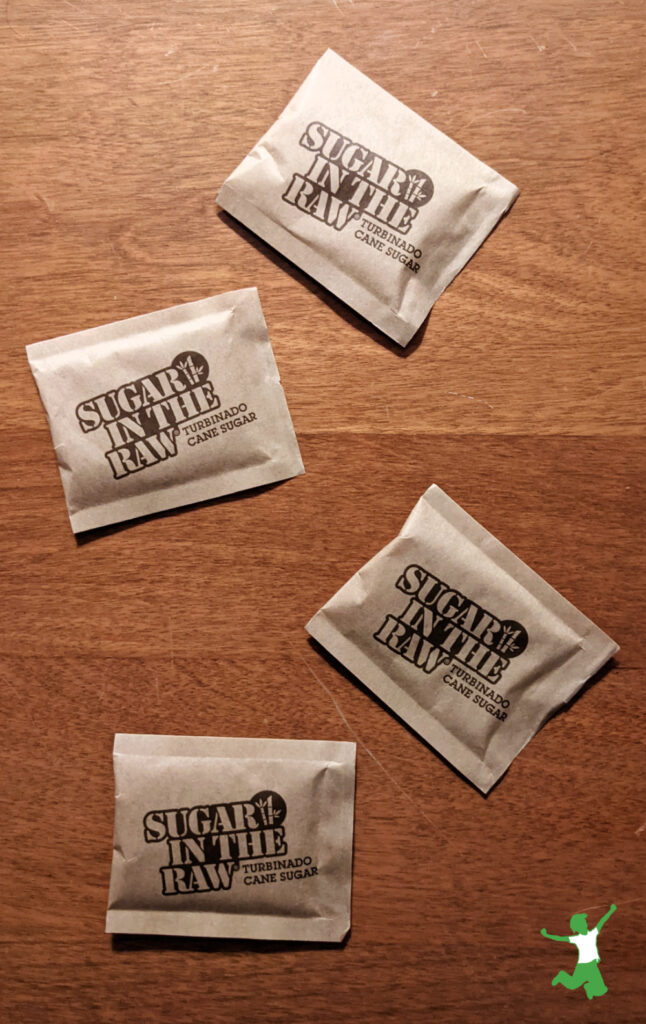Examination of the marketing claim of Sugar in the Raw and whether it is a whole, unprocessed sweetener retaining all the minerals of raw cane juice.

If a food is labeled as “raw”, what exactly does that mean?
To a consumer like me, raw means that the food is completely unadulterated. It has not in any way changed from its original natural form.
In other words, nothing has been added, removed, or heated to a temperature that would change any of the inherent nutritional characteristics.
Unfortunately, to food manufacturers, the definition of “raw” can be quite different.
In fact, raw to Big Food can translate to highly processed, industrialized food!
I’ve written before about how most raw cheese at the store is not raw at all in reality! In addition, cold-pressed raw milk and cold-pressed juice are not actually fresh either.
Sugar in the Raw Marketing Ploy
Another fake raw food at the store that is fooling a whole lot of people is “Sugar in the Raw”. It is also known as turbinado sugar or natural cane sugar.
But what about the “Good Housekeeping” seal of approval that sometimes appears on the box?
Doesn’t that mean that the Sugar in the Raw product is legitimate and to be trusted in its labeling claims?
Apparently not. Here’s what the manufacturer of Sugar in the Raw has to say about its product:
Enjoy sweet moments naturally with Sugar In The Raw®, our all-natural Turbinado sugar grown in the tropics. The hearty, golden crystals are never bleached, so they keep the rich flavor and color of their natural molasses. So go on, stir it in or sprinkle it on. Bake and cook with it too. Whatever you do, just do it naturally with Sugar In The Raw®.
It seems that just because Sugar in the Raw is unbleached makes it raw.
Perhaps that is what the USDA allows when it comes to labeling sugar products.
To me, sugar that is truly raw means much more than just unbleached. It means that nothing has been removed or added as well.
The marketing of this product is so sneaky because it leads the consumer to believe that the natural molasses is intact.
And, for Sugar in the Raw, a small amount of the molasses is indeed intact because it is a darker color than white sugar.
The truth, however, is that MOST of the molasses HAS been stripped away.
Comparison to Sucanat

Check out the picture above which shows a bowl of Sugar in the Raw next to a bowl of sucanat.
Notice the dark brown color of sucanat which is truly unprocessed cane sugar with all minerals, nutrients and molasses intact.
The lighter color of Sugar in the Raw indicates that the manufacturer has removed much of the mineral content.
In other words, the much darker sucanat visually demonstrates that Sugar in the Raw is a fake food masquerading as real.
It is an adulterated product contrary to the sneaky claims by the manufacturer.
What is the Best Cane Sugar?
Looking for the best and most nutritious form of cane sugar for your homemade cookies and cakes?
Sucanat is it! It is the best alternative to white or brown sugar substituted 1:1 in all your recipes.
It is best to bypass Sugar in the Raw or other turbinado sugar brands.
Florida Crystals is another cane sugar brand missing most of the molasses, so beware!
Most White or Brown Sugar is GMO
Another HUGE problem to watch out for is that most white or brown sugar in North America is partially or totally beet sugar. This sweetener is nearly always GMO unless certified organic.
GMO beet sugar is visually and taste-wise completely indistinguishable from white cane sugar.
Is beet sugar healthy? While it may seem so because it comes from a vegetable, the truth is that it is not!
Sugar from sugar beets is nutritionless and contaminated with gut-destroying glyphosate residue. Nearly 100% of farmers growing it use Monsanto’s Roundup Ready sugar beets.
A package of sugar must specifically state that the sweetener is cane sugar or be certified organic, else it is almost certainly a mixture that is wholly or partially GMO beet sugar.
Even brown sugar commonly contains at least some white beet sugar mixed with cane sugar molasses. The molasses from sugar beets is not fit for consumption.
To get the real thing, look for sucanat or sugarcane jaggery. Both are simply dried cane sugar juice with all minerals intact.
Ancestral cultures in India enjoyed these sweeteners for thousands of years.
What is a Safe Level to Consume?
While sucanat is your best choice when trying to find a truly natural and unprocessed substitute for processed cane sugar, be careful not to overdo.
Eating too much sugar can lower immunity, even if natural and unprocessed, in a manner similar to white sugar or partially processed sweeteners like Sugar in the Raw.
In summary, it always pays big dividends to do a little checking before buying into any labeling claims.
Sugar in the Raw is just another clever marketing scheme designed to make money off of consumers who genuinely are trying to improve their diets but don’t have quite enough information to make a completely informed decision.
Where to Find Truly Unprocessed Natural Sweeteners
Need help identifying truly natural, unprocessed whole sweeteners?
Please visit my Shopping Guide for a vetted list of vendors I buy from who offer quality sucanat, jaggery, coconut sugar, raw honey, maple syrup, and other wholesome sweeteners.
Beware that popular “healthy” sweeteners like xylitol and other sugar alcohols as well as brown rice syrup used in many organic foods and baby formula are highly processed. This is why making homemade baby formula is a better choice than commercial brands.









Sarah, if sucanat is off the table, what do you recommend instead?
Interesting. But according to Nourishing Traditions p536-537 “Guide to Natural Sweeteners”, sucanat is also not recommended. I am confused now.
I got my clay at whole foods and it was the facial clay 100% benodnite. I have heard there is a good website mountain rose herbs with quality herbs and minerals and stuff for good prices. I do really like the tootpaste. It seems my teeth feel clean all day. I found everything at Whole Foods. I don’t know it they have one in your area. I am in Missouri.
This all goes to show, once again, that you cannot trust a label.The photo showing the difference between the two sugars says it all.
In my city in Australia, in the health food stores, a small bag of Rapadura is expensive! Its organic but maybe for fermented beverages which is what I mainly use it for, I should go hunting in an Indian store, would the quality really be much different? If the colour is the same I’ll be happy. Is this better than substituting honey in recipes do you think?
By the way, I was at a demo of the vitamix at costco, and when the guy made a fruit smoothie, he of all things ruined it by putting Agave Syrup in it. He tried to pick an argument with me since he was angry that I wouldn’t taste his smoothie nor give it to the 3 yr old. I told him the fruit should have been enough sweetener. LOL!
I don’t know if you’ve done an article on Agave, but after the little bit that I’ve read, I do not use it at all.
So much to learn and so much information to get through….. So what is wrong with Agave ???
Great topic, and from reading the comments I didn’t realize so many people didn’t know. Off in my own little world I suppose. I love sucanat, and have been using it for more than 3 yrs. I also have tried many other sugars, date, coconut, billingtons molasses sugar, maple syrup, molasses and can’t remember what else. I use it for baking mostly.
While it’s best to cut down on sugars in the diet, including fruit sometimes we crave a sweet and this fits the bill.
for the pp who said if they want say a starbucks treat, then go for it. There are many reasons why I would not go for the “real” thing. First of all, I’d say it’s not real. Plus, I would be ill from all the additives that would be in a treat from anywhere. Preservatives, soy, corn syrup, dyes etc. can cause a lot of problems. Not to mention, they can make the sweet craving worse. I was the biggest sweetaholic of anyone I knew. By cutting down on my carbs, eating more veggies, and some fruit, I’ve found that I have the self discipline to not over indulge. I have no idea why, the chemistry behind it, but I’d never have believed it if it hadn’t happened to me.
I get my Sucanat from Azurestandard.com, which is situated in Oregon. I live in CA. I last ordered a 50lb. bag, but now realize that I’ll have to half that next time as our consumption over the past year has become very low.
Yes yes yes! Can I recommend a book by Gary Taubes to answer your “how” questions? Good Calories, Bad Calories is the long book, and Why We Get Fat is the shorter version. Happy learning!
I bought Sucanat a few weeks ago. When I opened the bag, the smell sickened me. I persevered and tried to use it in several ways. I’ve reached the point now where I actually gag when either the smell or taste hit me.
So, if I can’t use Sucanat, what would be the next best thing?
Raw honey? I substitute every need for sugar with raw honey
@Elle Yes! It is. You can get good quality clay from bulkherbstore.com. I use it for everything!!
If raw almonds are steamed, how come they will sprout for me?